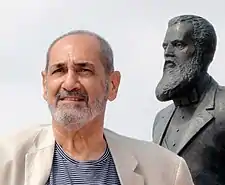Motti Mizrachi | |
|---|---|
מוטי מזרחי | |
 Motti Mizrachi (2012) | |
| Born | Mordechai Mizrachi 1946 |
| Nationality | Israeli |
| Education | Bezalel Academy of Art and Design |
| Known for | sculpture, multimedia |
| Notable work | Via Dolorosa (1973), The Eye of the Sun (2012) |
| Movement | Israeli art |
| Website | mottimizrachi |
Mordechai (Motti) Mizrachi (Hebrew: מוטי מזרחי, born 1946) is an Israeli multimedia artist who creates politically engaged conceptual works that combine sculpture, video, photography, public art and performance. [1] Dough, Via Dolorosa (1973) and Healing (1980) marked the emergence of avant-garde Israeli performance and video art. Since the 1980s, he has created numerous site specific public sculptures. [2]
Biography
Disabled since childhood, Motti Mizrachi uses humor and self-irony in his work, with an emphasis on the flaws and pleasures of the human body, while examining the oppression and control of the strong over the weak, both socially and politically. In 1969-1973, he studied at Bezalel Academy of Arts and Design in Jerusalem.[3] He was represented in the 1980 Biennale de Paris, the 1987 and 1981 São Paulo Art Biennials, the 1988 Venice Biennale, and the 2003 Valencia Biennale. [4]
Mizrachi lives in Tel Aviv, Israel.
Teaching
- 1980-1987 Bezalel, Jerusalem
- College of Art, School of Art Teachers, Ramat Hasharon
- Camera Obscura, Tel Aviv
Awards and recognition
- 1976 - Beatrice S. Kolliner Award for a Young Israeli Artist, Israel Museum, Jerusalem
- 1987 - Israeli Artist Award, Tel Aviv Museum and Bank Discount
- 1987 - Sandberg Prize for Israeli Art, Israel Museum, Jerusalem
- 1987 - Award, America-Israel Cultural Foundation
- 1997 - Prize to encourage creativity, Ministry of Education and Culture
- 2001 - Dan Sandel and Sandel Family Foundation Sculpture Award, Shoe Sculpture, Tel Aviv Museum of Art
- 2002 - Award, Israel Ministry of Science, Culture and Sport
Public Art

 The Fall of the Muses, 1991
The Fall of the Muses, 1991
Bronze
Ra'anana Park The Fall of the Muses, 1991
The Fall of the Muses, 1991
Bronze
Ra'anana Park

 Sprinkler, 1996
Sprinkler, 1996
Holon


See also
References
- ↑ Klein Leichman, Abigail. "Great Israeli road trips: Tel Aviv to Beersheva". 21 News.
- ↑ "The work of Motti Mizrachi cannot be easily classified".
- ↑ Cotter, Holland. "'DATELINE ISRAEL: NEW PHOTOGRAPHY AND VIDEO ART'". The New York Times.
- ↑ "Motti Mizrachi".
Further reading
- Agassi, Meir, Zadok Ben David, Motti Mizrachi. The Israeli Pavilion, The Venice Biennale 1988, Venice, 1988.
- Haifa Museums, Motti Mizrachi-Rwanda Casanova, Haifa Museums, 2000, ISBN 965-7067-18-9.
- The Israel Museum, Jerusalem
- curator: Lorand Hegyi, Makom: zeitgenössische Kunst aus Israel, Wien, Museum Moderner Kunst Stiftung Ludwig Wien, 1993, ISBN 3-900776-45-8.
- The Absent Body, Body Imagery Between Judaism and Christianity in the work of eight Israeli artists, Beit Hatfutsot, 2012, ISBN 978-965-425-024-5.
- Biennale di Valencia, 2003, Curator: Lorand Hegyi.
- "The Giving Person" group show, 2005, Napoli , Curator:Lorand Hegyi,( ISBN 88-510-0325-4).
- "Domicile - Private/Public", 2005, Saint-Etienne, Curator: Lorand Hegyi, 2005, (ISBN 2-85056-897-X).
- "Micro-Narratives", Saint-Etienne and later in Belgrade, 2008 ,Curator:Lorand Hegyi,(ISBN 978-88-6130-824-4).
- "Essential Experiences" 2009, Museum Palazzo Riso, Palermo, Curator: Lorand Hegyi, Catalogue: Essential Experiences Electa Editore, 2009, (ISBN 978-88-370-7433-3), together with Jan Fabre, Marina Abramovic, Richard Nonas, Dennis Oppenheim, Günther Uecker, Michelangelo Pistoletto, Lee Fan, Orlan, Gloria Friedmann.
External links
- MottiMizrachi.com Official website. Retrieved March 2012
- Motti Mizrachi YouTube channel. Retrieved March 2012
- Motti Mizrachi at the Information Center for Israeli Art. Israel Museum. Retrieved March 2012.
- Art of Motti Mizrachi at Europeana. Retrieved February 2012
- http://www.algemeiner.com/2015/10/02/whats-that-huge-white-bridal-dress-floating-over-the-tower-of-david/.. Retrieved November 2015.